Truffles
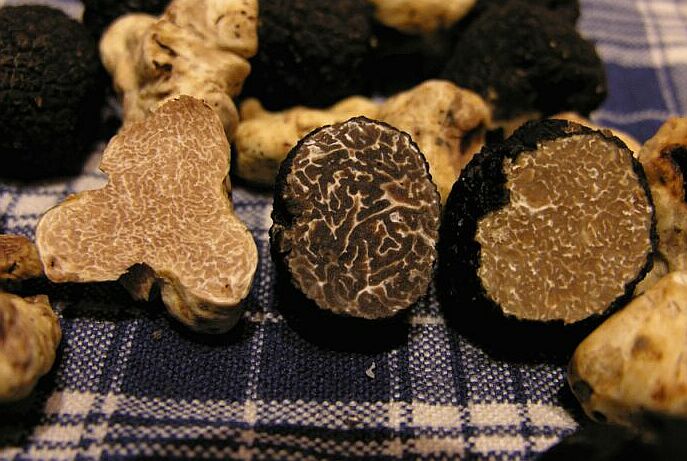 Some would say that truffles are the most glorious thing to come from the ground of planet earth and I would be hard pressed to disagree. Brillat-Savarin referred to them as the 'Diamonds of the Kitchen.' They are the most decadent of ingredients and per pound arguably the most expensive as well.
Some would say that truffles are the most glorious thing to come from the ground of planet earth and I would be hard pressed to disagree. Brillat-Savarin referred to them as the 'Diamonds of the Kitchen.' They are the most decadent of ingredients and per pound arguably the most expensive as well.
To enjoy the wonderfulness of the variously described pleasure of dining on truffles, you must eat fresh, uncooked specimens shortly after they have been harvested. The strength of the truffle flavor decreases rapidly with time, and much of it is lost before some truffles reach the market. However, lovers of these earthly gems advise us that freshly harvested truffles can be purchased in advance from some local specialty stores.
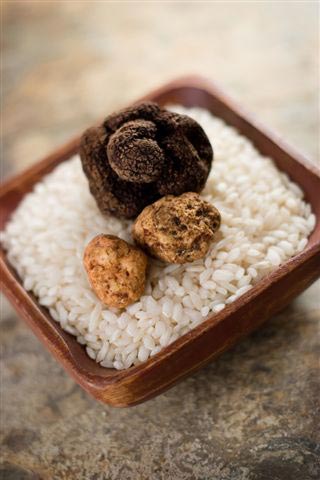 Wholesalers cover them with rice on restaurant serving trays in a refrigerated room as soon as they arrive. The next day they are delivered to the store where your order was placed. When you spend as much money as will be needed for such a culinary indulgence, use care to assure that you get truly fresh truffles.
Wholesalers cover them with rice on restaurant serving trays in a refrigerated room as soon as they arrive. The next day they are delivered to the store where your order was placed. When you spend as much money as will be needed for such a culinary indulgence, use care to assure that you get truly fresh truffles.
The term "truffle" as commonly used refers to members of the genera Tuber and Terfezia. Truffles are hypogeous (underground) versions of mushrooms. They don't form a prominent stem and their spore-bearing surfaces are enclosed. They rely on animals eating them (mycophagy) to distribute their spores, instead of air currents like mushrooms. Truffles resemble small potatoes, and often between the size of a marble and a golf ball. There are hundreds of different kinds of truffles, and while none are known to be poisonous, only a few of them are considered to be delicacies by humans. Truffles (and mushrooms) are only the "fruit" of the fungus (like an apple to an apple tree); the main perennial fungal body exists as a web of filamentous hyphae in the soil. All of the truffle fungi form mycorrhizae with the roots of trees, and are essential to the trees' ability to acquire nutrients. The belowground fruiting habit of truffles is thought to be an adaptation to forest fires or dry or frosty periods, in which aboveground mushrooms are more vulnerable.There are many other kinds of subterranean fungi, "false truffles," which outwardly resemble the ones we eat, and they are actually far more common than the ones collected for food with some poisonous as well. Truffles are round, warty, and irregular in shape and vary from the size of a walnut to that of a man's fist. The season for most truffles falls between September and May.
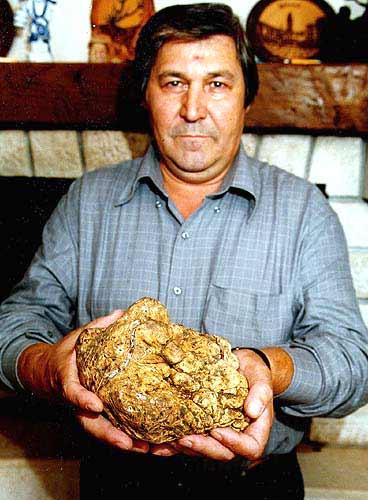 The mention of truffles conjures up images of the expensive French black truffle (Tuber melanosporum) from the Périgord region of southwest France, used in making pâté de foie gras, or the renowned odorous white truffle (Tuber magnatum) of Alba, in the Piedmont district of Italy. Since the times of the Greeks and Romans these fungi have been used in Europe as delicacies, as aphrodisiacs, and as medicines. They are among the most expensive of the world's natural foods, often commanding as much as $1,950 per pound.
The mention of truffles conjures up images of the expensive French black truffle (Tuber melanosporum) from the Périgord region of southwest France, used in making pâté de foie gras, or the renowned odorous white truffle (Tuber magnatum) of Alba, in the Piedmont district of Italy. Since the times of the Greeks and Romans these fungi have been used in Europe as delicacies, as aphrodisiacs, and as medicines. They are among the most expensive of the world's natural foods, often commanding as much as $1,950 per pound.
The Tuber magnatum truffles sell between $2,200 and $1,000 US per pound. Giancarlo Zigante (pictured left) and his dog Diana found one of the largest truffles in the world near Buje, Croatia. The truffle weighed 1.31 kilograms (2.9 lb) and has entered the Guinness Book of Records.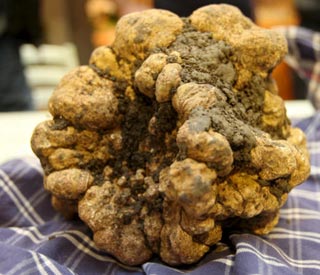
The record price paid for a single white truffle was set in December 2007, when Macau casino owner Stanley Ho paid US $330,000 (£165,000) for a specimen weighing 1.5 kilograms (3.3 lb), discovered by Luciano Savini and his dog Rocco. One of the largest truffles found in decades, it was unearthed near Pisa and sold at an auction held simultaneously in Macau, Hong Kong and Florence.
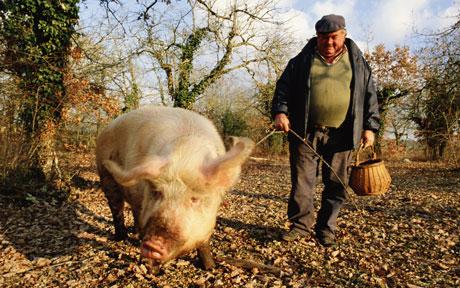 Truffles have been found in Europe, Asia, North Africa, and North America, but only three species are commercially important. They live in close mycorrhizal association with the roots of specific trees. Their fruiting bodies grow underground. Truffles are harvested with the aid of female pigs or truffle dogs, which are able to detect the strong smell of mature truffles underneath the surface of the ground. The use of pigs is risky,
Truffles have been found in Europe, Asia, North Africa, and North America, but only three species are commercially important. They live in close mycorrhizal association with the roots of specific trees. Their fruiting bodies grow underground. Truffles are harvested with the aid of female pigs or truffle dogs, which are able to detect the strong smell of mature truffles underneath the surface of the ground. The use of pigs is risky,  though, because of their natural tendency to eat any remotely edible thing. For this reason, dogs have been trained to dig into the ground wherever they find these odors, and they willingly exchange their truffle for a piece of bread and a pat on the head. Not a bad trade for the truffle hunter! Some truffle merchants dig for their prizes themselves when they see truffle flies hovering around the base of a tree. Once discovered, truffles can be collected in subsequent years at the same site.
though, because of their natural tendency to eat any remotely edible thing. For this reason, dogs have been trained to dig into the ground wherever they find these odors, and they willingly exchange their truffle for a piece of bread and a pat on the head. Not a bad trade for the truffle hunter! Some truffle merchants dig for their prizes themselves when they see truffle flies hovering around the base of a tree. Once discovered, truffles can be collected in subsequent years at the same site.
So what does a truffle taste like?
The flavor of the truffle is directly related to its aroma. The chemicals necessary for the odor to develop are created only after the spores are mature enough for release, so they must be collected at the proper time or they will have little taste. This is the only sure indication that the mushrooms are ready to be harvested. This is the very reason why animals have proven to be the best means of assuring that the fungi collected will be flavorful.
Truffles come to America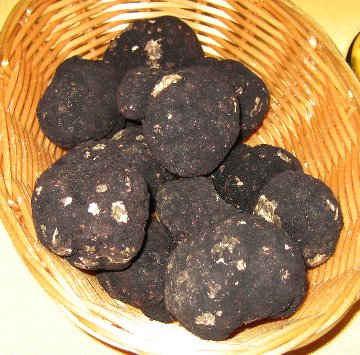 Gaining in popularity and comparing favorably with the Italian truffle, the Oregon truffle is harvested in sufficient quantity to support commercial sales. Although the Oregon truffle industry is in its infancy, it commands as much as $150 per pound for its truffles. James Beard claimed that the mature Oregon white truffle could be substituted for European varieties.
Gaining in popularity and comparing favorably with the Italian truffle, the Oregon truffle is harvested in sufficient quantity to support commercial sales. Although the Oregon truffle industry is in its infancy, it commands as much as $150 per pound for its truffles. James Beard claimed that the mature Oregon white truffle could be substituted for European varieties.
Originally found in California, the Oregon truffle grows in association with Douglas fir trees and is a major food source for many small rodents and other mammals. These underground fungi depend on animals to remove them from below the surface of the earth and to disperse the spores that result in the continuation of their species. Here is an example of complex ecology in which the tree, the fungus, and the animal depend on each other.
Cooking with truffles
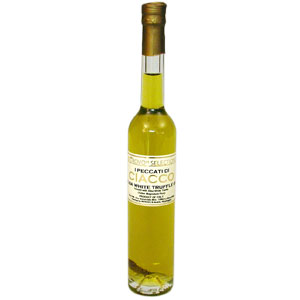 Truffle oil is a modern culinary ingredient added to foods, which is intended to impart the flavor and aroma of truffles to a dish. Most truffle oils are not, in fact, made from actual truffles, but are instead a synthetic product that combines a thioether (2,4-dithiapentane), one of numerous organic aromatics odorants found in real truffles, with an olive oil base. A few more expensive oils are alleged to be made from truffles or the by-products of truffle harvesting and production, though the flavor of truffles is difficult to capture in an oil.
Truffle oil is a modern culinary ingredient added to foods, which is intended to impart the flavor and aroma of truffles to a dish. Most truffle oils are not, in fact, made from actual truffles, but are instead a synthetic product that combines a thioether (2,4-dithiapentane), one of numerous organic aromatics odorants found in real truffles, with an olive oil base. A few more expensive oils are alleged to be made from truffles or the by-products of truffle harvesting and production, though the flavor of truffles is difficult to capture in an oil.
Truffle oil, available in all seasons and steady in price, is popular with chefs (and diners) because it is significantly less expensive than actual truffles, while possessing some of the same flavors and aroma. The emergence and growth of truffle oil has led to an increase in the availability of foods claiming to be made with or flavored with truffles, in an era when the price of truffles has pushed them out of reach for most cherfs/diners.
T. magnatum, the most aromatic of the truffles, is crushed in olive oil in Italy, filtered, and dispensed in 3-ounce medicine bottles with eye droppers. Some suspect that the crushed truffles are then packed in cans for sale in foreign markets. Call local cooking schools or specialty shops to locate this juice. Only a few drops are needed to strengthen the flavor of prepared truffles.
 When using raw truffle
When using raw truffle
The fungus is scraped or grated onto food and into sauces and soups just before eating. Truffle slicers have been specially designed for this purpose. Experts recommend that veal, chicken, fish, soufflés, omelettes, pasta, and rice can be glorified with thinly sliced truffles. Cream and cheese sauces avidly take up their flavor. Insert thin wedges of truffle under the skin of a chicken and store it overnight in the refrigerator before roasting.
A well-known chef prepares a high-quality pâté de foie gras baked with a stainless steel tube running through the center. As soon as the pâté is cooked, he fills the tube with diced uncooked truffles and then removes the tube.
To keep and store truffles
The pungent odor of a truffle will penetrate the shells of eggs and flavor kernels of rice when stored with them in a closed glass jar placed in a refrigerator. Once the prize truffle has been consumed, the eggs may be enjoyed in an omelette and the rice in pilaf.
Not cleaned to be used immediately:
Gently wash them with water and brush (best if with a vegetable brush, clean toothbrush or nail brush), and lightly pat dry with a paper towel.
Not cleaned, and stored:
Do not wash or brush until the day of use. To delay their ripening wrap in an absorbent paper towel or cloth, and store in the back or vegetable drawer of the refrigerator. Change the paper once a day. Alternatively, store in a jar of rice to absorb moisture and keep dry (plus the rice will absorb the truffle aroma and flavor, and will make a great risotto later).
If Cleaned:
Roll separately in an absorbent paper towel, paper bag, or absorbent cloth. Alternatively, store inside a jar or bag of rice. Change the paper towel every day, to absorb any moisture that may cause rot. Store in the back of the refrigerator or the vegetable drawer. Truffles can be frozen for two weeks in a freezer-proof glass jar. Another recommendation is to store them whole in bland oil.





